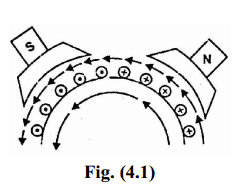Electrical DC Motor Working Principle:
The figure below is an electric dc motor.Want to know what is an electrical dc motor.It is an electrical machine which converts electrical energy into mechanical energy.This electric dc motors can be operated by giving both AC current and DC current.
- It has input and output terminals.Input terminals are connected to electric current and mechanical energy is collected from output terminals.
- It works on the principle of Faraday’s laws of electromagnetic induction.
The internal parts of an electric motor are shown below in the figure:
Working Principle of DC Electric Motor:
A machine that converts d.c. power into mechanical power is known as a d.c.
motor. Its operation is based on the principle that when a current carrying
conductor is placed in a magnetic field, the conductor experiences a mechanical force.The direction of this force is given by Fleming’s left-hand rule and magnitude is given by;
F = Bil newtons
Basically, there is no constructional difference between a d.c. motor and a d.c. generator.The same d.c. machine can be run as a generator or motor.Working principle of a dc motor can be explained from Fleming’s left-hand rule.
Fleming’s left-hand rule:
- According to Fleming’s left-hand rule, if a current carrying conductor is placed in a magnetic field then it experiences a force perpendicular to magnetic field and direction of the current.
- If we stretch thumb, forefinger and middle finger of the left hand perpendicularly and if forefinger represents the direction of magnetic field and middle finger represents the direction of current then thumb represents the direction of force the current carrying conductor experiences.
Working of D.C. Motor:
Consider a part of a multipolar d.c. motor as shown in the below figure.When the terminals of the motor are connected to an external source of d.c. supply:
(i) the field magnets are excited developing alternate N and S poles;
(ii) the armature conductors carry currents. All conductors under N-pole
carry currents in one direction while all the conductors under S-pole
carry currents in the opposite direction.
Suppose the conductors under N-pole carry currents into the plane of the paper and those under S-pole carry currents out of the plane of the paper as shown in the above figure.Since each armature conductor is carrying current and is placed in the magnetic field, a mechanical force acts on it.Referring to the above figure and applying Fleming’s left-hand rule, it is clear that force on each conductor is tending to rotate the armature in an anticlockwise direction. All these forces add together to produce a driving torque which sets the armature rotating.
When the conductor moves from one side of a brush to the other, the current in that conductor is reversed and at the same time, it comes under the influence of next pole which is of opposite polarity.Consequently, the direction of the force on the conductor remains the same.
Commutator present will give unidirectional torque.If it’s not there then the conductor movement(force) would have been reversed every time when the direction of magnetic field is changed.This is how do a dc motor works.


